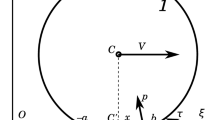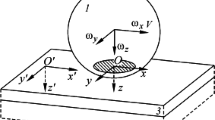Abstract
This paper investigates the influence of the material properties on the deceleration dynamics of a deformable cylinder rolling with slipping on a half-space of the same material. The interaction of the cylinder and the half-space is described by the 2D quasistatic contact problem of viscoelasticity (Goryacheva: J Appl Math Mech 37(5):877–885, 1973; Contact mechanics in tribology. Kluwer, Dordrecht 1998) which includes as limiting cases the absolutely rigid and elastic materials. Full dynamical analysis of the problem including the phase portrait, the dependence of the deceleration distance on the mechanical properties of the contacting bodies and on the friction coefficient is provided. The qualitative features of deceleration are justified by asymptotic analysis.






Similar content being viewed by others
References
Goriacheva, I.G.: Contact problem of rolling of a viscoelastic cylinder on a base of the same material. J. Appl. Math. Mech. 37(5), 877–885 (1973)
Goryacheva, I.G.: Contact mechanics in tribology. Kluwer, Dordrecht (1998)
Marques, F., Flores, P., Claro, J.C.P., Lankarani, H.M.: Modeling and analysis of friction including rolling effects in multibody dynamics: a review. Multibody Syst. Dyn. 45(2), 223–244 (2019)
Filippov, A.F.: Differential equations with discontinuous righthand sides: control systems, vol. 18. Springer, Berlin (2013)
Anitescu, M., Potra, F.A.: Formulating dynamic multi-rigid-body contact problems with friction as solvable linear complementarity problems. Nonlinear Dyn. 14(3), 231–247 (1997)
Pfeiffer, F., Glocker, C.: Multibody dynamics with unilateral contacts. Wiley, New York (1996)
Antali, M., Stepan, G.: Nonsmooth analysis of three-dimensional slipping and rolling in the presence of dry friction. Nonlinear Dyn. 97(3), 1799–1817 (2019)
Pöschel, T., Brilliantov, N.V., Zaikin, A.: Bistability and noise-enhanced velocity of rolling motion. Europhys. Lett. (EPL) 69(3), 371–377 (2005)
Vil’ke, V.G., Migunova, D.S.: The motion of a ball on a grassy lawn. J. Appl. Math. Mech. 75(5), 560–567 (2011)
Al-Bender, F., Van Brussel, H., De Moerlooze, K.: A generalised asperity-based friction model. Tribol. Lett. 40, 113–130 (2010)
De Moerlooze, K., Al-Bender, F., Van Brussel, H.: Modeling of the dynamic behavior of systems with rolling elements. Int. J. Non-Linear Mech. 46, 222–233 (2011)
Zobova, A.A.: Dry friction distributed over a contact patch between a rigid body and a visco-elastic plane. Multibody Syst. Dyn. 45(2), 203–222 (2019)
Leine, R.I., Glocker, C.: A set-valued force law for spatial coulomb-contensou friction. Eur. J. Mech. A/Solids 22(2), 193–216 (2003)
Kireenkov, A.A., Semendyaev, S.V., Filatov, V.F.: Experimental study of coupled two-dimensional models of sliding and spinning friction. Mech. Solids 45(6), 921–930 (2010)
Kudra, G., Awrejcewicz, J.: Application and experimental validation of new computational models of friction forces and rolling resistance. Acta Mech. 226(9), 2831–2848 (2015)
Kudra, G., Szewc, M., Wojtunik, I., Awrejcewicz, J.: Shaping the trajectory of the billiard ball with approximations of the resultant contact forces. Mechatronics 37, 54–62 (2016)
Contensou, P.: Couplage entre frottement de glissement et frottement de pivotement dans la théorie de la toupie. In: Kreiselprobleme/Gyrodynamics, pp. 201–216. Springer (1963)
Zhuravlev, V.P.: The model of dry friction in the problem of the rolling of rigid bodies. J. Appl. Math. Mech. 62(5), 705–710 (1998)
Alinia, Y., Zakerhaghighi, H., Adibnazari, S., Güler, M.A.: Rolling contact problem for an orthotropic medium. Acta Mech. 228(2), 447–464 (2017)
Buezas, F.S., Fochesatto, N.S.: Power dissipation of a viscoelastic rolling wheel in finite deformations. Int. J. Mech. Sci. 138, 502–514 (2018)
Balci, M.N., Dag, S.: Solution of the dynamic frictional contact problem between a functionally graded coating and a moving cylindrical punch. Int. J. Solids Struct. 161, 267–281 (2019)
Goryacheva, I., Miftakhova, A.: Modelling of the viscoelastic layer effect in rolling contact. Wear 430, 256–262 (2019)
Iguchi, Y., Hemthavy, P., Saito, S., Takahashi, K.: Analytical solution of elastic deformations inside and outside circular contact area between tilted rigid punch and elastic half space. Acta Mech. 230(12), 4311–4320 (2019)
Nili, A., Adibnazari, S., Karimzadeh, A.: Rolling contact mechanics of graded coatings involving frictional heating. Acta Mech. 230(6), 1981–1997 (2019)
Shahani, A.R., Babaei, M.: The crack propagation path for a system of surface and subsurface cracks and their interactions due to rolling contact fatigue. Acta Mechanica, pages 1–14 (2020)
Goryacheva, I.G., Zobova, A.A.: Dynamics of the motion of an elastic cylinder along an elastic plane. Mech. Solids 54(2), 271–277 (2019)
Zobova, A.A., Goryacheva, I.G.: Dynamics of a viscoelastic cylinder on viscoelastic half-space. Acta Mech. 231, 2217–2230 (2020)
Carter, F.W.: On the action of a locomotive driving wheel. Proc. R. Soc. London Ser. A 112(760), 151–157 (1926)
de Jesus, V.L.B., Sasaki, D.G.G.: Vídeo-análise de um experimento de baixo custo sobre atrito cinético e atrito de rolamento. Revista Brasileira de Ensino de Física 36(3), 1–6 (2014)
Suárez, Á., Baccino, D., Martí, A.C.: Video-based analysis of the transition from slipping to rolling. Phys. Teach. 58(3), 170–172 (2020)
La Salle, J., Lefschetz, S.: Stability by Liapunov’s direct method with applications. Elsevier, Amsterdam (2012)
Rouche, N., Habets, P., Laloy, M.: Stability theory by Liapunov’s direct method, vol. 4. Springer, Berlin (1977)
Arnold, V.I., Afrajmovich, V.S., Il’yashenko, YuS, Shil’nikov, L.P.: Dynamical systems V: bifurcation theory and catastrophe theory, vol. 5. Springer, Berlin (2013)
Goryacheva, I.G., Zobova, A.A.: Deceleration of a hard cylinder sliding on a viscoelastic base. Mech. Solids 54(2), 278–288 (2019)
Author information
Authors and Affiliations
Corresponding author
Additional information
Publisher's Note
Springer Nature remains neutral with regard to jurisdictional claims in published maps and institutional affiliations.
The part of the work related to the dynamic analysis was performed under the support of the Russian Foundation for Basic Research (Project 19-01-00140), and the part related to the contact problem analysis within the framework of a State assignment, State registration No. AAAA-A20-120011690132-4.
Appendix
Appendix
Statement 1
(full dissipativity). The kinetic energy of the cylinder
decreases in time for all the motions except for full rest (\(\tilde{V}= 0\) and \(\tilde{\omega }= 0\)).
Proof
Using Eq. (5), the time derivative of the kinetic energy on the solutions \(\tilde{V}(\tilde{t})\), \(\tilde{\omega }(\tilde{t})\) can be expressed in two equivalent forms:
Based on the calculation results shown in Fig. 2, in the full slipping regime \(|\delta |\ge \delta _\alpha ^*(\tilde{V})\), we consider the term \(\tilde{Q}= \mu \,\mathrm {sign}(\tilde{\omega }-\tilde{V})\) as the leading one in Eq. (5). Hence, \(|\tilde{Q}|>|\tilde{M}|\) and \(\mathrm {sign}\Big (\tilde{Q}+\tilde{M}/2\Big ) =\mathrm {sign}\tilde{Q}\). Besides, we have (see Sect. 3)
Therefore, from (15) we get \(\dfrac{\mathrm{d}T}{\mathrm{d}\tilde{t}}<0\) for \(\tilde{V}\ne 0\) (since \(|\delta |\ge \delta _\alpha ^*(\tilde{V})\), then \(\tilde{\omega }\ne \tilde{V}\)).
If \(|\delta |<\delta _\alpha ^*(\tilde{V})\), then \(2+\delta >0\) and from (16), we get again \(\dfrac{\mathrm{d}T}{\mathrm{d}\tilde{t}}<0\) for \(\tilde{V}\ne 0, \tilde{\omega }\ne 0\). Besides, we notice that \( \frac{\mathrm{d}T}{\mathrm{d}\tilde{t}} = 0\) if and only if \(\tilde{\omega }= 0\) and \(\tilde{V}= 0\) simultaneously. \(\square \)
Statement 2
(Global asymptotical stability of the equilibrium). There exists a unique asymptotically stable fixed point \(\tilde{V}= 0\), \(\tilde{\omega }= 0\) of Eq. (5); all solutions of these equations tend to this point: \(\tilde{V}(\tilde{t})\rightarrow 0,\tilde{\omega }(\tilde{t})\rightarrow 0\).
Proof
follows from Barbashin–Krasovskii–LaSalle principle [31, 32] with a full energy of the system as Lyapunov function. \(\square \)
Statement 3
(slow manifold). For any initial condition, there exists an instant \(\tilde{t}^*\) such that for any \(\tilde{t}>\tilde{t}^*\), the phase curve goes in \({\mathcal {O}}(\kappa ^{-1})\)—neighborhood of the slow manifold that is defined by the equation
Thus, the estimate
holds true on the solution \(\tilde{V}(\tilde{t})\), \(\tilde{\omega }(\tilde{t})\) of Eq. (5) for \(\tilde{t}>\tilde{t}^*\).
Proof
Let us consider dynamics of the system in the variables
where C is the value of the first integral for rigid and elastic case defined in Eq. (11) and \(V_s = \delta \tilde{V}\) is the slippage. Then, the governing equations equivalent to Eq. (5) have the form
Since the leading term in the right-hand side of Eq. (21) is \(\tilde{Q}\) and \(\tilde{M}= {\mathcal {O}}({\kappa ^{-1}})\), then \(C(\tilde{t})\) is a slow variable and \(V_s(\tilde{t})\) is a fast variable. For any fixed value of C, there exists a unique asymptotically stable critical point \(V_s^* = V_s^*(C)\) of the fast equation (Eq. (21)). The critical points are defined in the following equation where the inverse to Eq. (19) coordinate change is used:
Thus, the critical points of Eq. (21) in initial variables have the form \(\tilde{V}^* = \tilde{V}^*(V_s^*(C),C)\) and \(\tilde{\omega }^* = \tilde{\omega }^*(V_s^*(C),C)\).
These critical points form a slow manifold that includes the origin of the phase space \(\tilde{V}= \tilde{\omega }= 0\). After a finite time \(\tilde{t}^*\), the phase point moves in its \({\mathcal {O}}(\kappa ^{-1})\) – neighborhood slowly [33]; thus,
Substituting it into Eq. (17), we get Eq. (18). \(\square \)
Lemma
Proof
In [34, Appendix] using the asymptotics of Bessel functions, it has been shown that \(\lambda = 1\), \(\varepsilon = 0\) and \(1/\zeta = 0\) for \(\tilde{V}= 0\). Hence, from Eq. (7) we get
\(\square \)
Statement 4
(asymptotically exponential deceleration). For any initial conditions and for any constant \(k>0\), there exists a time instant \(\tilde{t}^{**}=\tilde{t}^{**}(k)<+\infty \) and a constant \(K=K(k)\) such that the velocity \(\tilde{V}\) decreases faster than exponentially:
Note that the constant K depends also on initial conditions.
Proof
We calculate the time derivative with respect to Eq. (5):
Substituting here \(\tilde{Q}\) from Eq. (18), we get
Having \(\tilde{V}(\tilde{t})\rightarrow 0\) (Statement 2) and based on the lemma, we conclude that for any \(k>0\), there exists a finite time instant \(\tilde{t}^{**}\ge \tilde{t}^*\) such that
and therefore,
Integrating through time and neglecting the terms of order \(O(\kappa ^{-1})\), we get
\(\square \)
Theorem
(finiteness of the distance till stop). For viscoelastic material with parameters \(\kappa \gg 1\), \(\alpha >1\) and friction coefficient \(\mu >0\) for any initial conditions \(\tilde{V}_0\) and \(\tilde{\omega }_0\), the axis of the cylinder moves on a finite distance.
Proof
The distance till stop is
Since the kinetic energy (14) does not increase, we have
and using Statement 4, we have
\(\square \)
Remark
The theorem is not true for elastic materials \((\alpha = 1)\). In this case, the distance till full stop is infinite for almost all initial conditions.
Rights and permissions
About this article
Cite this article
Zobova, A.A., Goryacheva, I.G. Effect of contacting bodies’ mechanical properties on the dynamics of a rolling cylinder. Acta Mech 232, 1971–1982 (2021). https://doi.org/10.1007/s00707-020-02800-w
Received:
Revised:
Accepted:
Published:
Issue Date:
DOI: https://doi.org/10.1007/s00707-020-02800-w




